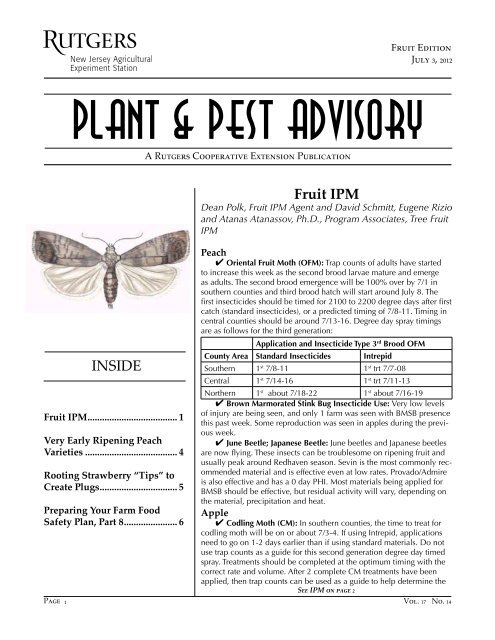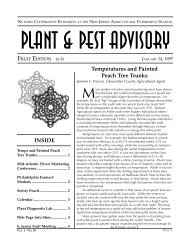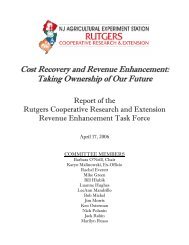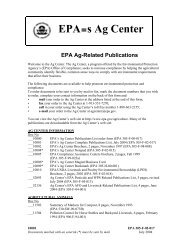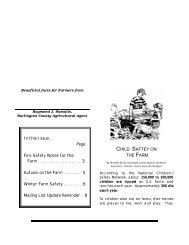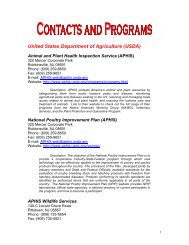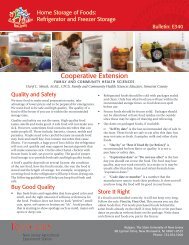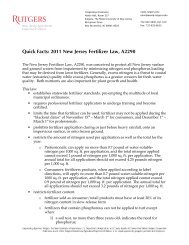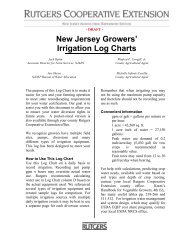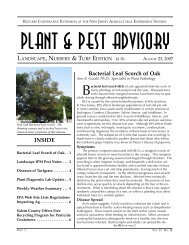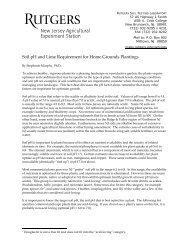View - Rutgers New Jersey Agricultural Experiment Station
View - Rutgers New Jersey Agricultural Experiment Station
View - Rutgers New Jersey Agricultural Experiment Station
You also want an ePaper? Increase the reach of your titles
YUMPU automatically turns print PDFs into web optimized ePapers that Google loves.
Fruit Edition<br />
July 3, 2012<br />
Plant & Pest Advisory<br />
A <strong>Rutgers</strong> Cooperative Extension Publication<br />
INSIDE<br />
Fruit IPM...................................... 1<br />
Very Early Ripening Peach<br />
Varieties....................................... 4<br />
Rooting Strawberry “Tips” to<br />
Create Plugs................................. 5<br />
Preparing Your Farm Food<br />
Safety Plan, Part 8....................... 6<br />
Fruit IPM<br />
Dean Polk, Fruit IPM Agent and David Schmitt, Eugene Rizio<br />
and Atanas Atanassov, Ph.D., Program Associates, Tree Fruit<br />
IPM<br />
Peach<br />
✔ Oriental Fruit Moth (OFM): Trap counts of adults have started<br />
to increase this week as the second brood larvae mature and emerge<br />
as adults. The second brood emergence will be 100% over by 7/1 in<br />
southern counties and third brood hatch will start around July 8. The<br />
first insecticides should be timed for 2100 to 2200 degree days after first<br />
catch (standard insecticides), or a predicted timing of 7/8-11. Timing in<br />
central counties should be around 7/13-16. Degree day spray timings<br />
are as follows for the third generation:<br />
Application and Insecticide Type 3 rd Brood OFM<br />
County Area Standard Insecticides Intrepid<br />
Southern 1 st 7/8-11 1 st trt 7/7-08<br />
Central 1 st 7/14-16 1 st trt 7/11-13<br />
Northern 1 st about 7/18-22 1 st about 7/16-19<br />
✔ Brown Marmorated Stink Bug Insecticide Use: Very low levels<br />
of injury are being seen, and only 1 farm was seen with BMSB presence<br />
this past week. Some reproduction was seen in apples during the previous<br />
week.<br />
✔ June Beetle; Japanese Beetle: June beetles and Japanese beetles<br />
are now flying. These insects can be troublesome on ripening fruit and<br />
usually peak around Redhaven season. Sevin is the most commonly recommended<br />
material and is effective even at low rates. Provado/Admire<br />
is also effective and has a 0 day PHI. Most materials being applied for<br />
BMSB should be effective, but residual activity will vary, depending on<br />
the material, precipitation and heat.<br />
Apple<br />
✔ Codling Moth (CM): In southern counties, the time to treat for<br />
codling moth will be on or about 7/3-4. If using Intrepid, applications<br />
need to go on 1-2 days earlier than if using standard materials. Do not<br />
use trap counts as a guide for this second generation degree day timed<br />
spray. Treatments should be completed at the optimum timing with the<br />
correct rate and volume. After 2 complete CM treatments have been<br />
applied, then trap counts can be used as a guide to help determine the<br />
See IPM on page 2<br />
Page 1 Vol. 17 No. 14
IPM from page 1<br />
need for supplemental applications. Based on recent research we are placing a 100 degree day delay in the degree<br />
day table published in the Tree Fruit Production Guide. Use the following chart to time applications:<br />
Codling Moth Degree Day Timing<br />
Application and Insecticide Type<br />
County Area<br />
Rimon; Intrepid;<br />
Diamides:<br />
1250-1300DD<br />
1550-1600DD<br />
Standard Insecticides,<br />
1350DD<br />
1650-1700DD<br />
DD 1250 1300 1550 1350 1650 1700<br />
Southern 6/30 7/2 7/10 7/3 7/14 7/16<br />
Central 7/4 7/5-6 7/14 7/7 7/18 7/20-22<br />
Northern 7/7-8 7/9-10 7/20-22 7/11-12 7/25-26 7/27-29<br />
✔ Hot Weather and Sunburn: A number of apple plantings, especially in northern<br />
counties, have exhibited sunburn injury on fruit (see photo). Surround WP can be applied<br />
to mitigate this injury, but is normally used prior to the occurrence of excessive<br />
heat and sunburn conditions. Even so, use of this product may minimize further injury,<br />
especially if more heat is yet to come.<br />
Sunburn symptoms on apple.<br />
Grapes<br />
✔ Grape Berry Moth (GBM): Trap captures are picking up. The first applications<br />
for generation 2 are on July 2 nd in southern counties. This is the timing for Intrepid and<br />
the diamides. Other materials can be applied a couple of days later. On Friday newly hatched larvae were observed<br />
in low numbers feeding under the skin in Atlantic County. No injury was seen in vineyards in Gloucester County.<br />
Trap captures are increasing which maybe an indication that most mating is over. Regional differences may greatly<br />
influence insect development and may account for a slightly earlier hatch in some vineyards. A summary of the first<br />
generation flight is in the table below. This is based on the model that predicts optimal control at 810 degree days<br />
after wild grape bloom.<br />
✔ Grape Root Borer (GRB): Grape Root Borer adults have begun flying in southern counties. This has not been<br />
a major pest of commercial Vineyards in <strong>New</strong> <strong>Jersey</strong>. The following is taken from the Virginia Tech Web Site<br />
(http://www.virginiafruit.ento.vt.edu/GRB.html):<br />
“This species overwinters as larvae in two different stages of development. The life cycle takes two years<br />
to complete (some studies indicate a three-year cycle), and almost all of this is spent as larvae feeding on grape<br />
roots. They bore into the roots and crown below the soil surface, reducing the productivity of the vine. Roots may<br />
be hollowed and sometimes packed with frass. Vines eventually die; there may also be increased susceptibility to<br />
cold injury. Young larvae are spread throughout the root zone while older larvae are found on larger roots close<br />
to the trunk. Ninety per cent of the pupae are within 35 cm of the trunk and the mean depth in the soil is 9-10<br />
cm. A lack of plant vigor is usually the first sign of the presence of this pest. Another indication is the presence of<br />
cast pupal skins protruding from the soil near the base of the trunk in late July and August.<br />
Full-grown larvae are about 25 mm long, white, and have brown heads. They leave the roots and pupate<br />
in cocoons near the soil surface beginning in June. Adults emerge 35-40 days later, beginning in about the<br />
first week of July, with greatest numbers present in the last two weeks of July. Moths are wasplike in appearance.<br />
The body is generally brown. The top of the head has orange; antennae are orange with brown-black<br />
markings; the abdomen is dark brown with reddish-brown markings, with a very narrow yellow band on<br />
posterior edge of segments two, four, and sometimes on six. Legs are orange with brown-black markings.<br />
The forewings are dark and mostly opaque. The hind wing is more transparent. These moths are daytime fliers.<br />
After flying for several days, females begin ovipositing on grape foliage, canes, and weeds. Each female<br />
lays an average of 300 eggs. About two weeks after hatching, first instar larvae drop to the ground and tunnel<br />
to roots. The greatest natural mortality occurs at this point in the life cycle. Only 1.5-2.7% survive the first<br />
stage because of predation, parasitism, and desiccation; but, once established in roots, mortality is very low.<br />
Infested vines are usually encountered randomly across a vineyard. Larvae do not travel very far in the soil,<br />
usually remaining on the roots of a single vine.”<br />
See Grapes on page 3<br />
Page 2 Vol. 17 No. 14
Grapes from page 2<br />
Captures Southern Counties<br />
Date GBM GRB<br />
5/19 1.13<br />
5/26 0.46<br />
6/2 1.71<br />
6/9 0.29 0<br />
6/16 0.43 0<br />
6/23 2 0<br />
6/30 3.29 .8<br />
This has been a sporadic pest in NJ vineyards, but is more common in southern<br />
counties. A Kentucky threshold suggests that treatment be used if 5% of the vines<br />
show visible pupal skins. The most common control is to apply Lorsban 4E in mid to<br />
late July to the crown and on the soil at the base of the plant. Apply on the soil to an<br />
18” radius around the crown, and do not allow the spray to contact foliage or fruit.<br />
This year’s timing will be during the first half of the month. The insecticide forms a<br />
barrier that kills young larvae, larvae as they emerge from eggs, and adults as they<br />
deposit eggs.<br />
Scouting Calendar<br />
The following table is intended as an aid for orchard scouting. It should not be<br />
used to time pesticide applications. Median dates for pest events and crop phenology<br />
are displayed. These dates are compiled from observations made over the past 5-10 years in Gloucester County.<br />
Events in northern <strong>New</strong> <strong>Jersey</strong> should occur 7-10 days later.<br />
Pest Event or Growth Stage Approximate Date 2012 Observed Date<br />
Pit Hardening Peach June 16 +/- 8 Days June 13<br />
3 rd Pear Psylla Hatch June 28 +/- 1 Days Not yet observed<br />
San Jose Crawlers 2 nd Generation July 21 +/- 5 Days Not yet observed<br />
Blueberry<br />
✔ Spotted Wing Drosophila (SWD) and Blueberry Maggot (BBM): Trap captures have gradually increased over<br />
the past week. Where some of our vinegar traps have had “0” to low counts, an observation on Monday 7/2, showed<br />
that many of our blueberry maggot traps were also catching high numbers of SWD on the same farms where the<br />
vinegar traps were at “0”. Some yeast traps also had high numbers. By now SWD is likely spread across most farms.<br />
We have also found a few hanging blueberry samples with larvae. Given the widespread nature of this pest, the lack<br />
of thresholds and good monitoring tools, and the fact that some fruit is infested, it is prudent to go to a regular protective<br />
schedule for any fields that have yet to be picked. See last newsletter for products and suggestions, and make<br />
sure to be careful with preharvest intervals and the lack of established MDLs if your fruit is intended for export.<br />
✔ Aphids: We are seeing less aphids compared to the previous week. About 67% of samples are positive, and<br />
26% exceed the 10% infestation level. Small colonies and single aphids make up most of the positive sightings. Very<br />
strong predator activity has been seen on occasion. Recent heat and the hardening of plant tissue have also been factors<br />
in the population decline.<br />
✔ Oriental Beetle(OB): Adults are still mating and laying eggs in the field. If not done already, there is still time<br />
to treat if needed, especially for ‘Duke’ if the field harvest has been completed. Do not extend treatments past the<br />
middle of July this year, since it is likely that this year’s larvae will be too old by late July to be adequately controlled.<br />
✔ Leafrollers and Other Leps: Leafroller larval activity is a rare sight in the field at this time. Only 1% of shoot<br />
and beating tray samples show low levels of larvae.<br />
✔ Putnam Scale: About 22% of fruit samples are positive for scale, and 4% exceed the 1% infestation level.<br />
Only a small number of sites have had high levels of infestation this season. Some of the active areas seen this year<br />
have had no history of problems during past seasons. Crawler traps are almost 0 at this time so treatments should<br />
not be made until activity begins again later in July or early August.<br />
Trap Counts – Southern Counties<br />
Week ending STLM TABM-A CM AM OFM-A DWB OFM-P TABM-P LPTB PTB<br />
6/2 33 16 5 5 58 1 30 39 0<br />
6/9 13 12 3 2 60 0 13 60 1<br />
6/16 7 5 2 3 37 0 5 21 2<br />
6/23 47 2 1 1 51 0 2 35 3<br />
6/30 22 0 1 2 29 0 1 19 2<br />
Trap Counts – Northern Counties<br />
Week ending STLM CM TABM-A AM DWB OBLR OFM-P TABM-P LPTB PTB<br />
6/2 163 5.4 14.2 8.8 6.7 0.5 17.2 18.1 0.2<br />
6/9 114 3.3 21.2 5.8 21.3 0.4 23.9 10.8 0.5<br />
6/16 76 4.1 19.1 5.8 10.3 0.3 22.9 9.4 0.3<br />
6/23 135 2.4 14.9 0 4.0 7.0 0.5 16.7 5.1 0.1<br />
6/30 146 1.3 7.8 0 5.0 1.3 1.4 10.4 4.1 0.8<br />
Page 3 Vol. 17 No. 14
Very Early Ripening<br />
Peach Varieties<br />
Jerome L. Frecon, <strong>Agricultural</strong> Agent<br />
Very early ripening peach varieties began maturing<br />
on June 11, with the harvest of Rich May.<br />
This was about ten days earlier than normal, and this<br />
has continued through this harvest. We were well into<br />
Sentry and Flamin Fury® PF#7 harvest on the first of July.<br />
This was to be expected with the early bloom we had in<br />
March and unless it becomes very cool I would expect<br />
it to continue through the harvest season. This was the<br />
earliest bloom and the earliest harvest I have seen in<br />
the 30 plus years I have been evaluating peaches and<br />
nectarines in southern <strong>New</strong> <strong>Jersey</strong>.<br />
Most of our very early varieties have been exposed<br />
to heavy pressure for bacterial spot, powdery mildew/<br />
rusty spot, and blossom blight. I have also seen a few<br />
more shattered and split pits but this has been dependent<br />
on location and probably due to low temperatures<br />
during fruit set and early fruit development.<br />
Yellow fleshed peach varieties – Raycrest ripened<br />
after Rich May on June 14 while Queencrest ripens just<br />
after Raycrest. Queencrest is still the nicest of the three<br />
that are moderately susceptible to bacterial spot. Spring<br />
Flame® 21 ripens just after Queencrest about June 17<br />
and is still the most attractive but is highly susceptible<br />
to bacterial spot. Spring Prince ripening with Spring<br />
Flame® 21 has looked very nice with great color, uniform<br />
size and shape, and good firmness, but this year<br />
had a high amount of bacterial spotting on the fruit. This<br />
spotting has caused me to reduce my excitement for<br />
this variety. Sunbrite was very attractive this year and<br />
has held its firmness well, ripening with Spring Prince<br />
and Spring Flame® 21. Desiree NJ 350 cultivar also<br />
ripens in this season. Desiree has great size, has<br />
been very attractive, and is firm. All of our peaches in<br />
this very early season have had above average flavor.<br />
Desiree ripened about June 18 just ahead of Flamin<br />
Fury® PF# 5B and Carored. Desiree has more red<br />
color and averages better size than Flamin Fury® PF#5B.<br />
Carored has been very attractive with good firmness and<br />
color but is susceptible to bacterial spot unlike Flamin<br />
Fury® PF#5B and Desiree. Earlystar ripens with<br />
Carored and had very good color. The Earlystar trees<br />
were small and had quite a bit of bacterial spot. We<br />
saw no very early yellow-fleshed varieties in the <strong>Rutgers</strong><br />
NJAES breeding program better than Desiree or the<br />
other very early yellow-fleshed varieties.<br />
White–fleshed peach varieties – We have evaluated<br />
two very early white-fleshed varieties from the <strong>Rutgers</strong><br />
NJAES fruit breeding program that did not have bacterial<br />
spot. Spring Snow, a very nice, low acid, white-fleshed<br />
variety, ripened about June 20. Sugar May ripens just<br />
after Spring Snow with more red color, and bacterial<br />
spot but not the size or flavor of Spring Snow. Manon<br />
another white-fleshed peach from France has been tested<br />
for many years. Our test trees have been removed but<br />
we see it in grower’s orchards. It has been a better variety<br />
than Sugar May with a brighter color, better flavor<br />
and size. We have also seen some very early white and<br />
yellow-fleshed nectarines from the <strong>Rutgers</strong> NJAES breeding<br />
program that may be introduced. One, NJ N100, a<br />
white-fleshed selection has been patented and offered<br />
by Adams County Nursery. NJ 100 is a full red attractive<br />
nectarine with very good flavor. It does not get bacterial<br />
spot and has better flavor than Jade. It is not as large as<br />
Arctic Star but does not exhibit the problems of cracking,<br />
skin finish and bacterial spot of Arctic Star and Jade.<br />
NJ N100<br />
Page 4 Vol. 17 No. 14
Rooting Strawberry “Tips”<br />
to Create Plugs<br />
Steve Bogash and Kathy Demchak, Penn State<br />
Horticulture and Extension<br />
Source: Penn State Extension, The Vegetable & Small<br />
Fruit Gazette, Volume 16, Issue 7, July 2012<br />
1) Use tips only from a reputable source. Tissue cultured<br />
mother plants are the preferred source. Using tips from<br />
your own or other local fields can create future problems,<br />
as there is the potential to move diseases and mites<br />
from field to field. Also, many varieties are patented and<br />
require licensing in order to take cuttings. USDA varieties<br />
are not patented, and can be propagated at no charge.<br />
2) Ideally, tips should be planted as soon as they arrive.<br />
However, if this is not possible, the tips may be stored<br />
at 34˚F and 75-80% humidity for up to 2 weeks from<br />
the date they were harvested from the mother plants.<br />
If you’re in a pinch for time and cooler space, pack<br />
the plants in ice. Allow 35 days from planting to grow<br />
a field-ready plug. Trim any runner cord to a 3/8-1/2<br />
inch stub before planting.<br />
3) Carefully cull the tips you are going to plant. Anything<br />
that looks at all questionable should be discarded.<br />
4) Sort tips by size. Do not plant small and large tips in<br />
the same trays, as the smaller plants are likely to get<br />
shaded. The smaller plants in this now lower canopy<br />
in the flat are ripe for botrytis and powdery mildew as<br />
air circulation will be poorer in the lower canopy.<br />
5) Plant the tips in plug trays with 50 cells/tray. Use a sterile<br />
media designed for rooting herbaceous “bare-rooted”<br />
plants. This includes most professional grower mixes.<br />
If you are recycling trays, be sure to remove all organic<br />
matter from them, then chlorine dip (1 part liquid bleach<br />
to 9 parts clean water) the trays prior to use. Be careful to<br />
avoid contamination of the propagation area.<br />
6) The hook on the tip should be just in the potting media.<br />
Do not bury the crown.<br />
7) Do not fertilize just planted tips. The fertilizer charge<br />
in most potting media will be sufficient until the plants<br />
are well-rooted. Fertilize for the first time at two weeks<br />
after planting using 100 ppm of nitrogen with calcium<br />
nitrate as the source, and repeat at weekly intervals. If<br />
you are holding the plants for longer than 4-5 weeks<br />
(thus creating super plants), switch to 20-20-20 at 100<br />
ppm of nitrogen for later applications.<br />
8) Your goal is to keep the leaves moist until the tips<br />
start to create their own roots. Hot, sunny days will<br />
require extra mist, while cooler, cloudy days less mist.<br />
The assumption with the following misting regimen is<br />
that you will be placing the new tips in a greenhouse<br />
or high tunnel. Enclosed structures will require less<br />
misting as wind will not dry the leaves as with plants<br />
growing outdoors. Do not allow the surface of the<br />
leaves to dry for the first 7 days. Mist using fogger<br />
nozzles of an intermediate discharge rate. Start with<br />
the following misting regimen, but adjust it as needed<br />
to prevent over-watering or desiccation of the leaves:<br />
a) Time for the system to reach operating pressure<br />
needs to be factored in as this regimen assumes<br />
actual misting time.<br />
b) Day 1-7: Use 5 seconds of mist every 15 minutes.<br />
c) Day 7-12: Gradually reduce misting. Keep the media<br />
moist. Misting should be terminated by the end<br />
of this period.<br />
d) After week 3, the plants should be well-rooted and<br />
ready to begin conditioning for field planting. Keep<br />
the media moist, but expose the plants to full sun<br />
by setting them on a field wagon or on groundcover<br />
fabric. Keeping them in a greenhouse or high tunnel<br />
is OK, but do not mist and maintain good airflow.<br />
e) Do not mist after sundown, even at first. Some<br />
growers believe misting after sundown can create<br />
bigger plugs, but the greater chance of disease<br />
offsets any possible benefits.<br />
Additional Recommendations<br />
● Plants can be rooted in either an enclosed structure<br />
(greenhouse/high tunnel) or outdoors. If outdoors,<br />
choose a protected location to keep the unrooted tips<br />
from being dislodged by wind or heavy rain. Be sure<br />
to put down a layer of groundcover fabric before rooting<br />
plants outdoors. Make sure your misting set-up is<br />
working ahead of time.<br />
● Shade cloth can be used to limit plant desiccation,<br />
but is not recommended. This will slow the time from<br />
sticking the tips to having field-ready plugs by about a<br />
week.<br />
● Soil inoculants such as Plant Shield and Mycostop may<br />
be advantageous in preventing soil-borne diseases.<br />
However, no definitive research has been done using<br />
these products on strawberry tips at this time. In other<br />
crops, these products have prevented a wide range of<br />
soil-borne diseases.<br />
● Due to the constant misting, control of diseases should<br />
be managed primarily with good ventilation. Any<br />
fungicides that are applied during the time the tips are<br />
being misted will be washed off too quickly to accomplish<br />
anything. However, a fungicide application to<br />
the plants prior to planting is probably a good idea.<br />
● Scout the plants for spider mites. Their eggs are tiny so<br />
use a hand lens. If any eggs or mites are found, treat<br />
before planting in the field. Materials for two-spotted<br />
spider mite control include: Vendex, Acramite, Oberon,<br />
Kanemite, Portal and Zeal. Zeal is only for eggs<br />
and immatures. As always, growers should closely<br />
follow label restrictions and requirements.<br />
Submitted by Jerome Frecon, <strong>Agricultural</strong> Agent. ❏<br />
Page 5 Vol. 17 No. 14
Preparing Your Farm<br />
Food Safety Plan<br />
Part 8: Creating Logs to Document<br />
Compliance – Storage and Transportation Logs<br />
Meredith Melendez, Mercer County Senior<br />
Program Coordinator and Wesley Kline, Ph.D.,<br />
Cumberland County <strong>Agricultural</strong> Agent<br />
The USDA Good <strong>Agricultural</strong> Practices audit<br />
requires that certain activities on the farm be<br />
documented. These logs should accurately reflect what<br />
you have done on the farm to ensure food safety. If you<br />
do not write your activities down the auditor will assume<br />
that the activity never happened. This documentation<br />
may be new for many growers, so making it as easy as<br />
possible for you to comply will ensure that the documenting<br />
happens in a manner that is acceptable to an<br />
auditor. This is the eighth article in a series dedicated to<br />
preparing a farm food safety plan. For previous articles<br />
refer to earlier editions of the Plant and Pest Advisory, or<br />
visit the <strong>Rutgers</strong> Vegetable Crops blog at:<br />
http://jerseyvegcropsagupdates.blogspot.com. Remember<br />
you may not need a third party audit; it depends on<br />
who is purchasing your produce. However, everyone<br />
should have a food safety plan.<br />
Storage Temperature Log<br />
Storage facilities that are refrigerated should be<br />
monitored daily during use. Make sure to check the<br />
temperature the same time each day to ensure correct<br />
temperatures. This log should indicate:<br />
✔ Date<br />
✔ Time<br />
✔ Temperature<br />
✔ Any necessary comments<br />
✔ Employees signature<br />
Thermometer Calibration Log<br />
Thermometers used in storages need to be checked<br />
for accuracy once a month during the growing season.<br />
The thermometer used to check storage temperatures<br />
should be calibrated before using your calibration log<br />
which should include the following:<br />
✔ Date<br />
✔ Thermometer location number<br />
✔ Time<br />
✔ Temperature<br />
✔ Were corrective measures needed? (Yes or No)<br />
✔ If corrective measures were needed briefly describe<br />
them.<br />
✔ Date corrective action was completed<br />
✔ Employees initials<br />
Calibration can be easily done. The following method<br />
is recommended by the USDA Food Safety Inspection<br />
Using the ice water method, fill a large glass with<br />
finely crushed ice. Add clean tap water to the top of the<br />
ice and stir well. Immerse the food thermometer stem a<br />
minimum of 2 inches into the mixture, touching neither<br />
the sides nor the bottom of the glass. Wait a minimum of<br />
30 seconds before adjusting. (For ease in handling, the<br />
stem of the food thermometer can be placed through the<br />
clip section of the stem sheath and, holding the sheath<br />
horizontally, lowered into the water.) Without removing<br />
the stem from the ice, hold the adjusting nut under the<br />
head of the thermometer with a suitable tool and turn<br />
the head so the pointer reads 32 °F. If a digital thermometer<br />
is used it can be checked in the same way. If<br />
the digital thermometer is not reading correctly check<br />
the instruction for adjustments or replace.<br />
Carrier Monitoring Log<br />
Keeping track of and monitoring the trucks that carry<br />
your product to various markets is a key component of<br />
your traceability program. The following information<br />
should be documented for each load that is taken from<br />
your farm:<br />
✔ Date<br />
✔ Time<br />
✔ Carrier<br />
✔ Trailer number<br />
✔ Drivers name<br />
✔ Trailers last load (previous)<br />
✔ Is the trailer clean, dirty, or washed<br />
✔ Is the trailer refrigerated? (Yes or No)<br />
✔ If the trailer is refrigerated, what is the temperature?<br />
✔ What produce was loaded onto the trailer.<br />
✔ Additional produce on the truck, if applicable?<br />
✔ Is there a temperature monitor installed in the<br />
trailer? (Yes or No)<br />
✔ Employees initials<br />
Next week: Farm Review<br />
Service:<br />
Page 6 Vol. 17 No. 14
Plant & Pest Advisory<br />
<strong>Rutgers</strong> School of Environmental<br />
and Biological Sciences<br />
ASB II, 57 US Hwy. 1<br />
<strong>New</strong> Brunswick, N.J. 08901<br />
PLANT & PEST ADVISORY<br />
FRUIT EDITION - CONTRIBUTORS<br />
<strong>Rutgers</strong> NJAES Cooperative Extension Specialists<br />
George Hamilton, Ph.D., Pest Management<br />
Norman Lalancette, Ph.D., Tree Fruit Pathology<br />
Bradley A. Majek, Ph.D., Weed Science<br />
Ann Nielson, Ph.D., Fruit Entomology<br />
Peter Oudemans, Ph.D., Small Fruit Plant Pathology<br />
Cesar Rodriguez-Saona, Ph.D., Cranberry/Blueberry Entomology<br />
Daniel Ward, Ph.D., Pomology<br />
<strong>Rutgers</strong> NJAES<br />
Joseph Goffreda, Ph.D., Breeding<br />
<strong>Rutgers</strong> NJAES - CE <strong>Agricultural</strong> Agents and Program Associates<br />
Atlantic County, Gary C. Pavlis, Ph.D. (609-625-0056)<br />
Gloucester County, Jerome L. Frecon (856-307-6450)<br />
Hunterdon County, Winfred P. Cowgill, Jr. (908-788-1338)<br />
Morris County, Peter J. Nitzsche (973-285-8300)<br />
Passaic, Elaine Fogerty, Agric. Assistant (973-305-5740)<br />
Warren County, (908-475-6505)<br />
Fruit IPM, Dean Polk (609-758-7311)<br />
Atanas Atanassov, Ph.D., Program Associate (908-788-1338)<br />
Gene Rizio, Program Associate (856-566-2900)<br />
David Schmitt, Program Associate (856-307-6450)<br />
<strong>New</strong>sletter Production<br />
Jack Rabin, Associate Director for Farm Services, NJAES<br />
Cindy Rovins, <strong>Agricultural</strong> Communications Editor<br />
Pesticide User Responsibility: Use<br />
pesticides safely and follow instructions<br />
on labels. The pesticide user<br />
is reponsible for proper use, storage<br />
and disposal, residues on crops, and<br />
damage caused by drift. For specific<br />
labels, special local-needs label 24(c)<br />
registration, or section 18 exemption,<br />
contact RCE in your County.<br />
Use of Trade Names: No discrimination<br />
or endorsement is intended in the<br />
use of trade names in this publication.<br />
In some instances a compound may<br />
be sold under different trade names<br />
and may vary as to label clearances.<br />
Reproduction of Articles: RCE invites<br />
reproduction of individual articles,<br />
source cited with complete article<br />
name, author name, followed by<br />
<strong>Rutgers</strong> Cooperative Extension, Plant<br />
& Pest Advisory <strong>New</strong>sletter.<br />
For back issues, visit our web site at:<br />
www.rce.rutgers.edu/pubs/plantandpestadvisory


